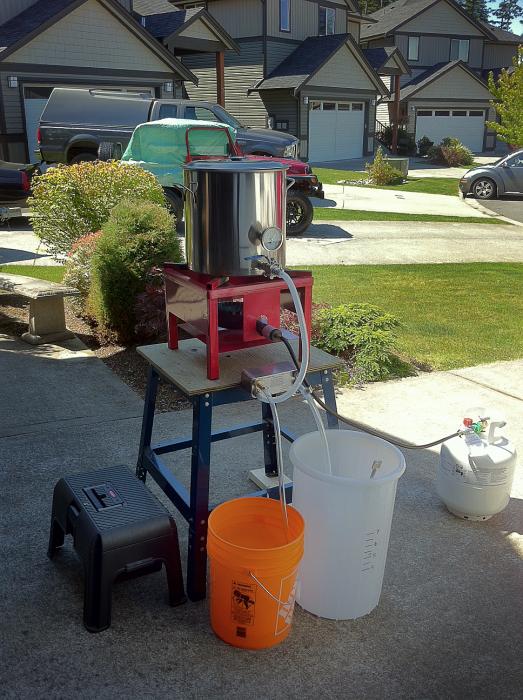bru-ster76
Well-Known Member
- Joined
- Jun 16, 2013
- Messages
- 73
- Reaction score
- 1
Hey!
I was hoping to brew this weekend, but there was way more things I needed to dial in before I jumped in, and I'm glad I did a system test with water only as I have come up with several questions from the process.
My system is a 65000BTU burner, 9G Kettle and 30 plate chiller. I boiled 6.25G of water, which is what my kit is going to require and it boiled for 60mins on a good solid rolling boil. I ended up with 4.75G (measured after chilling to 73F). Chilling took ~15mins to get that 4.75G to 73F. Now I have 3 groups of topic-based questions about this process.
1. I had reduced my burner after I got it boiling, but kept enough heat to keep it at an aggressive boil. Could I have reduced my heat further to lessen my boil off? (I was hoping to be closer to 5.25, but wasn't that lucky)
2. Should I aim to chill faster and settle at a higher temp? I was planning on fermenting at about 67F so I wanted to see if I could hit that temp to pitch at roughly the same temp as fermentation. Does this matter that much? Can I keep a lid on the wort while I clean up to further drop that temp before pitching, or is it best to begin pitching right after it's chilled?
3. I've read about trub, how much can I expect to leave in the kettle? my 4.75G was everything from the kettle, I just wonder if I should expect to leave everything below the ballvalve level behind or try and tip the kettle to get it out into the chiller.
Thanks in advance!
Here's a photo of my system.

I was hoping to brew this weekend, but there was way more things I needed to dial in before I jumped in, and I'm glad I did a system test with water only as I have come up with several questions from the process.
My system is a 65000BTU burner, 9G Kettle and 30 plate chiller. I boiled 6.25G of water, which is what my kit is going to require and it boiled for 60mins on a good solid rolling boil. I ended up with 4.75G (measured after chilling to 73F). Chilling took ~15mins to get that 4.75G to 73F. Now I have 3 groups of topic-based questions about this process.
1. I had reduced my burner after I got it boiling, but kept enough heat to keep it at an aggressive boil. Could I have reduced my heat further to lessen my boil off? (I was hoping to be closer to 5.25, but wasn't that lucky)
2. Should I aim to chill faster and settle at a higher temp? I was planning on fermenting at about 67F so I wanted to see if I could hit that temp to pitch at roughly the same temp as fermentation. Does this matter that much? Can I keep a lid on the wort while I clean up to further drop that temp before pitching, or is it best to begin pitching right after it's chilled?
3. I've read about trub, how much can I expect to leave in the kettle? my 4.75G was everything from the kettle, I just wonder if I should expect to leave everything below the ballvalve level behind or try and tip the kettle to get it out into the chiller.
Thanks in advance!
Here's a photo of my system.




